Sorel-Tracy
Sorel-Tracy (/sɔːˈrɛl træˈsiː/; French: [sɔʁɛl tʁaˈsi]) is a city in southwestern Quebec, Canada and the geographical end point of the Champlain Valley at the confluence of the Richelieu River and the St. Lawrence River, on the western edge of Lac Saint-Pierre downstream and east of nearby Montreal. The population as of the Canada 2011 Census was 34,600. Its mayor is Serge Péloquin and it is the seat of the Pierre-De Saurel Regional County Municipality and the judicial district of Richelieu.[6]
Sorel-Tracy | |
|---|---|
City | |
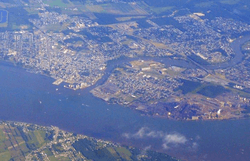 Aerial view of Sorel-Tracy | |
Location within Pierre-De Saurel RCM. | |
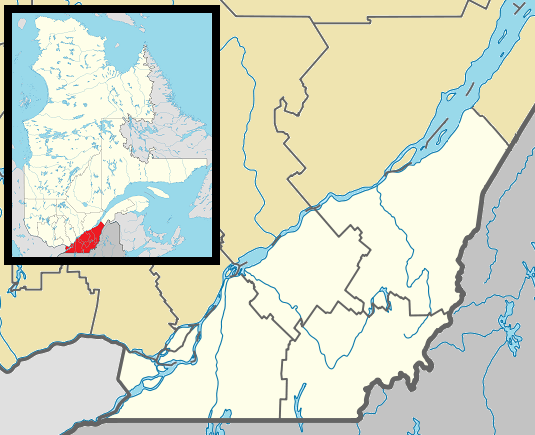 Sorel-Tracy Location in southern Quebec. | |
| Coordinates: 46°02′N 73°07′W[1] | |
| Country | |
| Province | |
| Region | Montérégie |
| RCM | Pierre-De Saurel |
| Constituted | March 15, 2000 |
| Government | |
| • Mayor | Serge Péloquin |
| • Federal riding | Bécancour—Nicolet—Saurel |
| • Prov. riding | Richelieu |
| Area | |
| • Land | 172.63 km2 (66.65 sq mi) |
| • Metro | 233.78 km2 (90.26 sq mi) |
| Population (2016)[4] | |
| • City | 41,629 |
| • Density | 241.1/km2 (624/sq mi) |
| • Metro | 47,772 |
| • Metro density | 204.3/km2 (529/sq mi) |
| • Pop 2011–2016 | |
| • Dwellings | 16,737 |
| Time zone | UTC−5 (EST) |
| • Summer (DST) | UTC−4 (EDT) |
| Postal code(s) | J3P-J3R |
| Area code(s) | 450 and 579 |
| Highways | |
| Website | www |
The city is the result of a voluntary amalgamation in 2001 between two cities, Sorel and Tracy. The Richelieu River separates the two communities; Tracy on the west shore and Sorel on the east shore. Sorel itself had annexed in 1992 the municipality of Saint-Pierre-de-Sorel which corresponds today to the southern part of its territory.
Sorel was founded in 1642. Tracy was founded on February 10, 1954. Prior to 1954, Tracy was known as the parish municipality of Saint-Joseph de Sorel (not to be confused with the town of Saint-Joseph-de-Sorel, an independent municipality north of Tracy).
Sorel-Tracy is known for its activities in the steel industry and metallurgy as well as for its ferry linking the city to the village of Saint-Ignace-de-Loyola.
History
The Battle of Sorel occurred on June 19, 1610, with Samuel de Champlain supported by the Kingdom of France and his allies, the Wyandot people, Algonquin people and Innu people that fought against the Mohawk people in New France.[7]
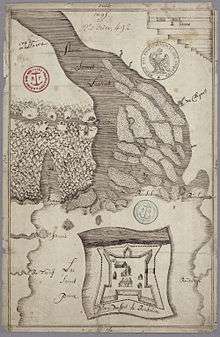
Sorel is the fourth oldest city in the province of Quebec. Its formation began in 1642 when Charles Huault de Montmagny, first Governor and Lieutenant-Governor of New France, built Fort Richelieu here as a defense for settlers and river travellers against the Iroquois. In 1647, the original fort was destroyed by the Iroquois but it was rebuilt by the Carignan-Salières Regiment on the same site in 1665.[8]
The name Sorel comes from the first seigneur of the area, Pierre de Saurel. He was in command of a regiment of the Carignan-Salières that came over in August 1665. He was granted a seigneury by King Louis XIV in 1672, even though he had already built a manor house four years prior. The name Tracy comes from Lieutenant General Alexander de Prouville, Sieur de Tracy, who was overall in command of the Carignan-Salières Regiment directly under the Governor.
It is in Sorel that the Christmas tree made its first appearance in North America on Christmas Eve in 1781. After the visit of Prince William Henry, Duke of Gloucester to Sorel in 1787 the town took the name of William-Henry, a name it retained until 1845.
It is probable that before the American Revolution there were no English speaking people in Sorel. Although then merely a hamlet or village, this place was the scene of much activity. During 1776 large bodies of troops passed through and at times were stationed in the area; the German auxiliaries employed by England were quartered in Sorel as they arrived in the country. A letter from Governor Frederick Haldimand to Lord George Germain in October 1778, written from his camp in Sorel where fortifications were in progress, indicates his proposed use of the Seigniory,
It is my intention therefore, if time and circumstances favour me, to make Sorel a place of strength with Permanent Works, as the importance of it deserves. The Seigneurie of this Place is vested in merchants residing in England and the Inhabitants of it, people remarkable for their courage and resolution, have distinguished themselves very much by their attachment to the Government even at a time the Rebels were Masters of that Country, in which account I think it would serve the King's interest to bestow some Public mark of favour upon them such as remitting them the Quitrents which they pay for their land, to the Seigneur, and the Seigneurie being to be sold, and the purchase would not exceed 13,000, having been offered for that sum, I submit to Your Lordship whether it would not be best to give orders to treat immediately with the Proprietors, Messrs. Greenwood and Higgins in London, both for enabling me to effect the purchase...
The purchase was eventually made in 1781 and Sorel became a clearing house for the steady stream of Loyalist refugees from the south. A certain number of them settled in Sorel, forming the nucleus of the English population. Another addition was Sorel being selected as one of the stations for "Military Invalids", or “Outside Chelsea Pensioners" as they were also called. These old soldiers and their dependents, numbering several hundreds, were sent to Sorel under the medical care of Dr. Christopher Carter.
The earliest efforts for the propagation of the Protestant religion in Canada were made in Sorel. The continued influx of Loyalists during the year 1783 into the Seigniory prompted the population to search out a permanent Minister, and so at the end of the year, a petition was sent to the Society for the Propagation of the Gospel in Foreign Parts, begging them to send a Minister of the Gospel to reside in the Seigniory.
Following the request, the Reverend John Doty embarked during the month of April 1784 at Gravesend, England, and arrived at Quebec in June, and at Sorel on 4 July 1784, where he celebrated Divine Service and preached his first sermon. This is the date of the foundation of the Anglican parish in Sorel and the first Anglican mission in Canada.
The chapel where the faithful united was a wooden building located at the end of King Street, a few steps from the Richelieu market. This building had already served as a military storehouse. At the beginning of the 19th century, Sorel was the home of fur traders. In 1819, the town's presbytery was declared dangerously unfit. The character of the town, however, would change dramatically over the next few decades, due to the arrival of two influential figures.
In the 1820s, Sorel was the site of the Governor General of Lower Canada's governor's house,[9] occupied George Ramsay, the Lord Dalhousie (after whom Dalhousie University is named). Ramsay quickly purchased land in the area for agricultural improvement. The small town was, due to the Governor General's presence, a centre for the turbulent politics of that time; the period leading up to the Lower Canada Rebellion.
Locally, there was animosity between the colonial governor and the other prominent local figure, parish priest Jean-Baptiste Kelly.
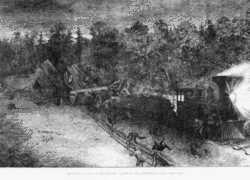
Kelly oversaw a number of improvements and changes during his years in the town. The "dangerous" presbytery was rebuilt by 1832 (using stone from the original). The town's name was changed from William-Henry back to Sorel in 1845. The parish library was improved, containing four hundred volumes by 1846. In 1848 a monument to temperance was built by the community, along with a society for the care of the poor and sick, and for the education of girls. Kelly retired in 1849, after the completion of a new presbytery, having turned the older one into a college.
In 1839 two new residents were involved in a murder trial. George Holmes, who lived in town, was in romantic pursuit of Joséphine d’Estimauville, who had been staying with family in William Henry. Holmes killed her husband Louis-Pascal-Achille Taché in the seigneury of Kamouraska. Holmes fled to the United States of America, and d’Estimauville was acquitted of any involvement. In 1970, Anne Hébert wrote a book, Kamouraska, about the affair, which was made into a film in 1973 by Claude Jutra.
Sorel was also the site of the construction of 3 out of 12 Halifax-class frigates of the Canadian Forces. The three Canadian patrol frigates built in Quebec were HMCS Ville de Québec, HMCS Regina and HMCS Calgary. The shipyard in Sorel-Tracy was called M.I.L. Tracy and built units for all three vessels and sent them by barge for final assembly at M.I.L. Davie in Lauzon, Quebec. Previous to the construction of the Halifax-class frigates, MIL (Marine Industries Ltd operated by the Simard family of Sorel) was responsible for the construction of HMCS Nipigon which was commissioned there in 1964. MIL was also the location of the construction of HMCS Bras d'Or, an experimental hydrofoil constructed by the Royal Canadian Navy. The construction of both ships was overseen by Cmdr. Donald Clark CD RCN.
Legacy
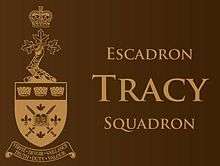
The Tracy Squadron at the Royal Military College Saint-Jean was named in honour of Sorel-Tracy.
Demographics
French Canadians make more than 97% of the city's population. Less than 2% of the population is foreign-born or second generation immigrants. Anglo-Canadians make less than 1% of Sorel-Tracy's inhabitants.
PopulationPopulation trend:[10]
(+) Amalgamated with Tracy on March 15, 2000. |
LanguageMother tongue language (2006)[11]
|
Transportation
Sorel-Tracy is within 75 kilometres (47 mi) of both Montreal and Trois-Rivières, and is easily accessible via Autoroute 30 from the west and via Route 132 from the east and west. Autoroute 30 stops at Sorel and picks up again at Bécancour, leaving an incomplete segment in between.
A year-round ferry operates on the St. Lawrence River between Sorel-Tracy and Saint-Ignace-de-Loyola on the way to Berthierville.
Notable people from Sorel-Tracy
The painter Monique Régimbald-Zeiber was born in Sorel.[12]
Athletes
- Professional ice hockey goaltender Marc-André Fleury, currently playing for the Vegas Golden Knights in the National Hockey League. The Pittsburgh Penguins in the National Hockey League drafted him 1st overall in 2003 and with whom he won the Stanley Cup in 2009, 2016, and 2017. He would then get drafted to the Vegas Golden Knights, leading them to the 2018 Stanley Cup Finals.[13]
- Retired professional hockey defenseman François Beauchemin who last played for the Anaheim Ducks in the NHL, and who won the Stanley Cup with the Anaheim Ducks in 2007.[14]
- Professional hockey left winger Anthony Beauvillier who currently plays for the New York Islanders in the NHL, who drafted him 28th overall in 2015.[15]
Public Officials
- Canadian politician Pierre Paquette, a member of the Bloc Québécois, a Canadian political party.
Sports
The city is home to the historic Colisee Cardin, an ice hockey arena built in 1954. The Sorel Eperviers played there from 1969–77 and 1980–81. They advanced to the league final in 1974, losing the President's Cup (QMJHL) to the Quebec Remparts. Since the foundation of the LNAH (formerly QSPHL) in 1996, Sorel-Tracy has hosted a team for all but two seasons, 2008–2010. The team was known variously as Dinosaures, Mission, Royaux, GCI and HC Caverna before taking the name Sorel-Tracy Eperviers in 2012.
Climate
| Climate data for Sorel-Tracy | |||||||||||||
|---|---|---|---|---|---|---|---|---|---|---|---|---|---|
| Month | Jan | Feb | Mar | Apr | May | Jun | Jul | Aug | Sep | Oct | Nov | Dec | Year |
| Record high °C (°F) | 12.8 (55.0) |
12.0 (53.6) |
21.1 (70.0) |
30.5 (86.9) |
34.4 (93.9) |
37.8 (100.0) |
36.7 (98.1) |
37.8 (100.0) |
33.9 (93.0) |
28.9 (84.0) |
22.8 (73.0) |
14.4 (57.9) |
37.8 (100.0) |
| Average high °C (°F) | −6.1 (21.0) |
−4.1 (24.6) |
2.1 (35.8) |
10.5 (50.9) |
18.9 (66.0) |
24.1 (75.4) |
26.6 (79.9) |
25.1 (77.2) |
19.3 (66.7) |
12.3 (54.1) |
4.8 (40.6) |
−2.8 (27.0) |
10.9 (51.6) |
| Daily mean °C (°F) | −11.2 (11.8) |
−9.2 (15.4) |
−2.9 (26.8) |
5.4 (41.7) |
13.1 (55.6) |
18.5 (65.3) |
21.2 (70.2) |
19.7 (67.5) |
14.3 (57.7) |
7.9 (46.2) |
1 (34) |
−7.3 (18.9) |
5.9 (42.6) |
| Average low °C (°F) | −16.2 (2.8) |
−14.4 (6.1) |
−7.9 (17.8) |
0.3 (32.5) |
7.2 (45.0) |
12.8 (55.0) |
15.7 (60.3) |
14.3 (57.7) |
9.3 (48.7) |
3.5 (38.3) |
−2.7 (27.1) |
−11.7 (10.9) |
0.9 (33.6) |
| Record low °C (°F) | −41.0 (−41.8) |
−37.8 (−36.0) |
−35.0 (−31.0) |
−28.9 (−20.0) |
−6.1 (21.0) |
−1.7 (28.9) |
4.4 (39.9) |
0.0 (32.0) |
−4.5 (23.9) |
−10.6 (12.9) |
−25.0 (−13.0) |
−40.6 (−41.1) |
−41.0 (−41.8) |
| Average precipitation mm (inches) | 74.3 (2.93) |
60.0 (2.36) |
66.8 (2.63) |
76.0 (2.99) |
85.8 (3.38) |
92.7 (3.65) |
90.9 (3.58) |
93.4 (3.68) |
81.1 (3.19) |
87.5 (3.44) |
89.3 (3.52) |
78.3 (3.08) |
976.1 (38.43) |
| Source: Environment Canada[16] | |||||||||||||
See also
- Battle of Sorel
- List of cities in Quebec
- Tracy Thermal Generating Station
References
- Reference number 360770 of the Commission de toponymie du Québec (in French)
- Ministère des Affaires municipales, des Régions et de l'Occupation du territoire: Sorel-Tracy
- Parliament of Canada Federal Riding History: BAS-RICHELIEU--NICOLET--BÉCANCOUR (Quebec)
- 2011 Statistics Canada Census Profile: Sorel-Tracy, Quebec
- 2016 Statistics Canada Census Profile: Sorel-Tracy (Census agglomeration), Quebec. The census agglomeration consists of Sorel-Tracy, Contrecoeur, Saint-Joseph-de-Sorel, Sainte-Anne-de-Sorel, Sainte-Victoire-de-Sorel. In the 2006 census, the census agglomeration had also included Saint-Ours.
- Territorial Division Act. Revised Statutes of Quebec D-11.
- Fischer, David Hackett (2008). Champlain's Dream. Random House of Canada. pp. 577–578. ISBN 978-0-307-39767-6.
- "Collections Canada". champlain2004.org. Archived from the original on June 15, 2017. Retrieved December 20, 2017.
- Image-Image. HistoricPlaces.ca; retrieved July 12, 2013.
- Statistics Canada: 1996, 2001, 2006, 2011 census
- 2006 Statistics Canada Community Profile: Sorel-Tracy, Quebec Retrieved April 30, 2018.
- "Artists in Canada". Canadian Heritage. Government of Canada. Retrieved 11 December 2018.
- Marc-André Fleury National Hockey League. Retrieved April 30, 2018.
- François Beauchemin National Hockey League. Retrieved April 30, 2018.
- Anthony Beauvillier National Hockey League. Retrieved April 30, 2018.
- Environment Canada Canadian Climate Normals 1971–2000 Government of Canada. Retrieved April 30, 2018.
External links
- Official website
- Histoire de Sorel-Tracy History of Sorel - timeline, bibliography, sources, etc.
- Chisholm, Hugh, ed. (1911). . Encyclopædia Britannica (11th ed.). Cambridge University Press.